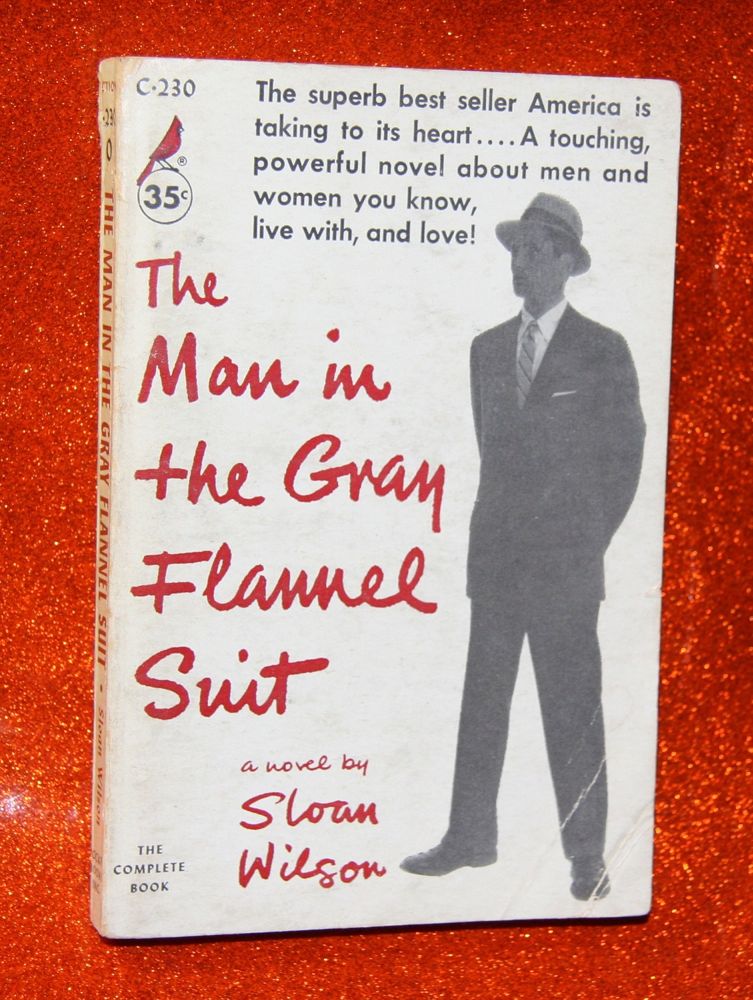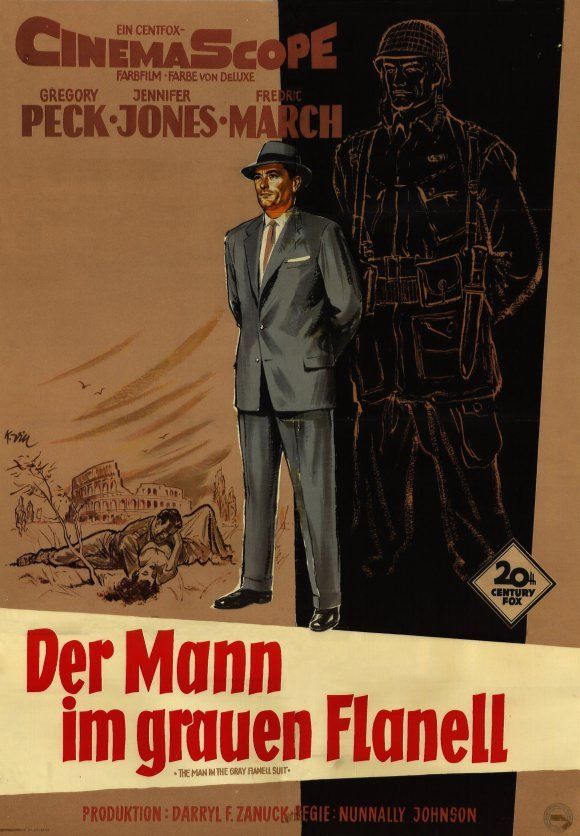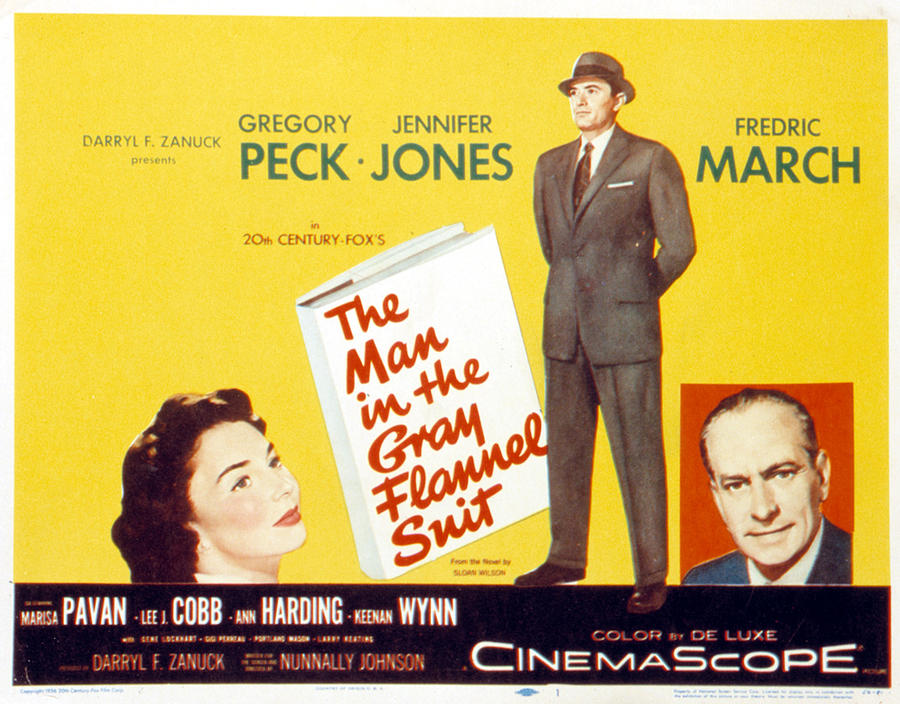PZ offers some thoughts on a novel and a film that have been regularly misunderstood, or at least mischaracterized:
The Man in the Gray Flannel Suit
This is an interesting movie (1956) and a very interesting book (1955). Sloan Wilson, a master novelist who understood marriage and men, wrote the novel. Darryl F. Zanuck produced the movie, and Nunnally Johnson scripted it and directed it. It starred Gregory Peck and Jennifer Jones.
Tom Rath, the gray-suited Westport commuter of The Man in the Gray Flannel Suit, is carrying inside himself absolute shock at the things he had to do in France in l944 and the losses he suffered in the Pacific right after that. No one knows this about Tom Rath — he is taciturn and diffident, like many survivors of that war. Not even his wife knows. There is another aspect, too, of his time overseas that returns to haunt him. Nothing can be compartmentalized, even on the New Haven Line.
The Man in the Gray Flannel Suit is a truly explosive novel and movie, nuclear but also abreactive. It is not about conformity. It is about engaging pain. Fortunately, Tom and Betty Rath do engage the pain. They are enabled somehow to go into it, rather than shy away from it. They are literally saved by a kind of confrontation with their suffering. Their story is almost ennobling.
When you think about the Eisenhower years, or if you have experienced a trauma since the Eisenhower years — like maybe last week — you could learn from Sloan Wilson. You could get something out of quiet Tom and not-so-quiet Betty Rath. Life’s acuteness forces them to go towards, not suppress and flee — like my own tendency, for example. It is not exactly “fight or flight” in the Raths’ case. But it’s certainly not flight.
While you’re at it, read Sloan Wilson’s Georgie Winthrop (1963) — the year of the Great Event we’ve been recently remembering. Poor George Winthrop. He is not allowed off the hook either. But he comes into something, too. Something good. Or at least, survivable.
[PZ also points out a telling difference between the U. S. and the European advertising art for the film. In the German poster above, the context of the tale is emphasized by the ghost of the soldier he once was standing behind and towering over the figure of Peck. In American advertising art, this ghost figure did not appear. This suggests that American audiences would not have been immediately attracted by an image of PTSD haunting returned American soldiers. That subject had to be treated obliquely, in the guise of crime thrillers, for example, in the film noir tradition, or in the guise of a tale about “suburban conformity”.]




Pingback: The anguish of ‘The Organization Man’ | New England Diary
Okay Lloyd, here’s one for somebody to answer…
The book was prefaced by a quote which, if I remember anywhere near accurately, went:
“So I asked of the man who knows,
Where are they going, and what do they carry,
And why do they hurry so?”
The only hint to the author of these lines was a couple of initials, and I’ve tried to identify the source for fifty-odd years. Anyone know?
I’m not absolutely sure of this, but I think ‘A.F.W.’ was Albert Frederick Wilson,
the father of Sloan Wilson.
Thanks for that, Paul. That quote has stuck with me over the years, and still pops into my head at times – especially when I look at the brave new world around me.
I also remember the moment when Tom Rath refuses to do what his boss asks, and the boss rages that people like Rath ride on the backs of people like him. A telling moment that was inversely paralleled for me years later when Pink Floyd sang: “Did you exchange a walk-on part in the war for a lead role in a cage?”.
I was wondering the same thing. : )
AFW is his father.
The following from: http://www.anb.org/articles/16/16-03566.html
Wilson, Sloan (8 May 1920-25 May 2003), writer, was born in Norwalk, Connecticut, to Albert Frederick Wilson and Ruth Danenhower. Sloan’s father was a college professor and author; his mother, trained as a sociologist, wrote a number of academic studies, including an account of segregation in the U.S. armed forces. His family, which included a brother and sister, lived in a series of different towns along the Eastern Seaboard during his childhood and youth, and he was educated at several institutions, including Phillips Exeter Academy in Exeter, New Hampshire. Wilson received his high school diploma from the Adirondack-Florida School in 1937 and the following year enrolled at Harvard, where he majored in philosophy and psychology.
I just noticed something which may have been obvious to everyone else. The figure on the paperback cover of “The Man In the Gray Flannel Suit” is posed exactly as Peck is posed on all the posters. That struck me as odd until I realized that the pose is “parade rest” in military parlance — something that might not be readily apparent to everyone but would be perfectly apparent to any of the millions of Americans who served in the armed forces in WWII.
So that ghost of a soldier in the European posters is really there in the American artwork, just very subtly.